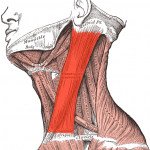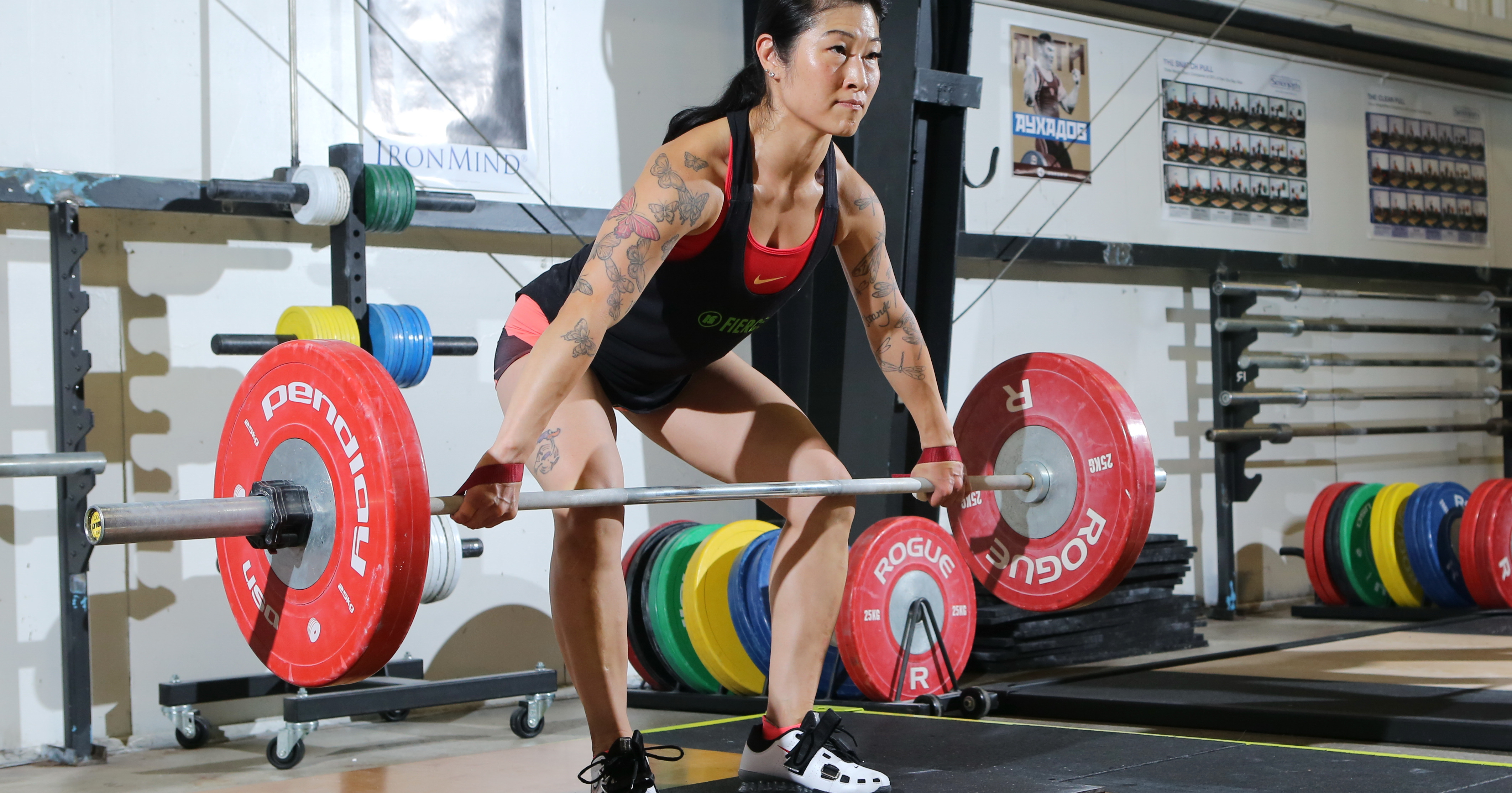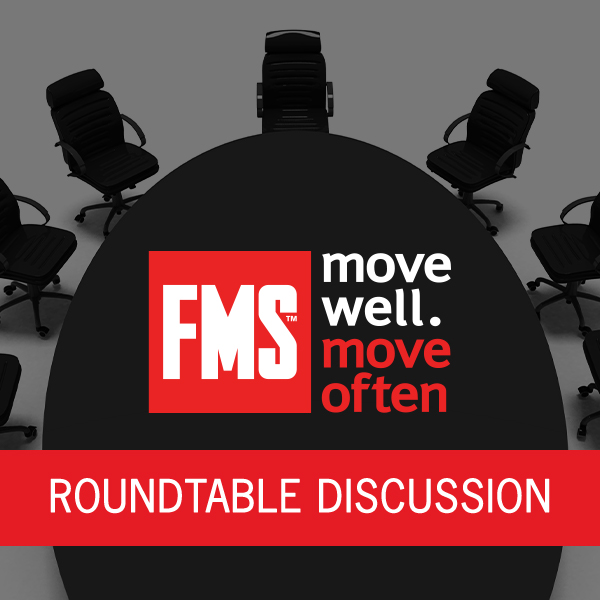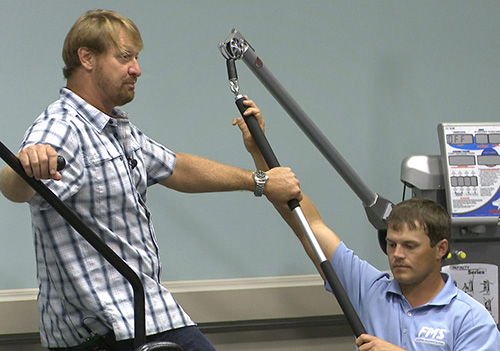The Momentum of Perspective
Written by Gray Cook FMS
Momentum is the driving force behind our professional passions. It’s a force that gives us confidence and reminds us not settle for being average. At its best, it represents the quality great professionals display as they seek the truth and use its lessons to help others. At its worst, it represents unsubstantiated dogma or blind allegiance to a doctrine that does not represent a compressive approach.
Different schools of thought should inspire us. They should motivate us and they should provide us with frameworks and systems. But they should not define us. This is why we wrote Movement, Functional Movement Systems around fundamental human movement principles—not methods. Unfortunately, the dogmatic disciple of a particular discipline is obligated to resist any new information. The disciple will not look for parallel principles, but will simply notice a different methodology and resist the strange, unfamiliar or different.
The well-rounded professional is eager to embrace any method designed around fundamental principles. Methods and systems are just the tools we use to adhere to our fundamental principles. If you are in this second group, you intuitively realize your formal schooling gave you the basic skills to explore, learn and educate yourself.
My formal education in exercise and physical therapy taught me how to not hurt people, and how to be responsible. My practical education, still in progress, teaches me how to help people, and how to become wiser. My practical education improves my efficiency and effectiveness. My practical experiences create my professional confidence and momentum.
My professional momentum and experience and the confidence it produces come from floor time—that is, time on the clinic floor, the gym floor or the training field. The recipe is simple and timeless: Develop a skill set and do something with it. Then get feedback and evaluate the outcome. Based on the outcome, do something else to get more feedback, and on, and on… Note, I did not suggest writing blog post about it, or reading five articles, or asking someone’s opinion to help form your own. You should know your material and already posses the necessary skills. It’s the particular situation you are expected to evaluate. Your practical education is all about lots of exposure to feedback, feedback gained from applying what you know across multiple trials, situations or problems.
I usually relate this to how we gain practical knowledge. With driving, we learn basic driver safety, but we must get time behind the wheel to complete the learning. As the founding developer of the Functional Movement Screen (FMS) and the Selective Functional Movement Assessment (SFMA), I get to teach many classes and workshops. The one instruction I regularly give is to get some practical education. I provide the schooling and provide the skill set so you can receive practical education on the floor.
Mark Twain says it best:
“I’ve never let my schooling interfere with my education.”
Today’s exercise and rehabilitation professionals are better schooled than ever before. My critique now is the lack of practical application and education. The FMS and SFMA are practical tools that do not rely on computer technology or fancy equipment. The tools are not sexy by technical standards, but they are totally practical. They are very efficient and effective. Each create perspective and practical confidence when dealing with movement dysfunction. They create momentum with perspective based on practical professional experience.
Here is how the momentum of my personal perspective came about. Looking back, it was a three-step process I did not plan, but in hindsight recognize its value.
Step One: As a young physical therapist I was blessed with an amazing opportunity in working under the direction of an accomplished expert in Physical Therapy. His name is Paul Hughes and he showed me that my schooling at the University of Miami was simply a ticket to my education—it was not my education. He taught me through repetition and practical example. Don’t make the mistake and think that my hand was held by a kind, nurturing sole. Paul is a demanding teacher and coach, and this was exactly what I needed. He is definitely a kind person, but he knew I needed systematic structure and practical skills. He showed me the pursuit of knowledge and truth is about early mornings, late nights, and lots of feedback—mostly constructive criticism. If I hadn’t have wanted this, the path was designed to quickly show me the exit.
I worked many nine- and ten-hour days. Eight hours of patient care and one or two hours of case review and critique a few times a week. I could not hide or cover my blunders and mistakes; I needed to own my mistakes and own up to them. As a matter of fact, I learned that mistakes are tuition-free educational opportunities if they are analyzed and discussed. I was accountable for all I contacted. I was forced to think fast and never rely on protocols or prepackaged programs, and was expected to clearly and efficiently incorporate my knowledge into each individual situation. I learned practical problem-solving and was expected to develop and use a systematic approach. If I did not achieve my goals with each patient, athlete or client, I was expected to discover how, where and why I made mistakes. Rarely were these mistakes directly pointed out to me—I was expected to find my own mistakes when my results were not great. I was also expected to discover ways to reduce and limit future errors.
A person who never made a mistake never tried anything new ~Albert Einstein
And so, without knowing it at the time, the seeds for functional movement screening and movement assessment were planted, but they needed time to germinate.
Step Two: After nearly three years under Paul, my mentor, I branched out and became the director of a clinic—a very young but confidant director.
- Sidebar Information: Most therapists my age had not seen or experienced the postgraduate practical education I was blessed to have. Some emerged from PT school with the assumption they were qualified, and I guess they were correct, however to be blunt, they were minimally qualified just as I was upon graduation. Medical licensure is about minimum competency, not expertise. Ironically, new graduates had the same professional distinction as my mentor. Even though the new graduate and Paul Hughes were both considered licensed physical therapists, they practiced at completely different comprehensive levels.
As the new director of an established physical therapy clinic, I decided it was my responsibility to take the most difficult cases, and to lead by example. From that point, I started doing more and more evaluations. The majority of my slots were reserved for evaluation or re-evaluation. I was still involved in treatment, but on a limited basis. When I evaluated a patient, I performed a trial treatment, observed the indicators that demonstrated I was on the right track and allowed another staff member to take over the case while I moved on to another. If the plan was successful, feedback from the staff noted all the goals were met. If it was not, I re-assessed the patient. In a nutshell, my learning was accelerated by my exposure to more cases in a shorter amount of time. I got to observe many movement patterns and follow the outcomes either directly or indirectly. My learning loops were compressed.
Step Three: Three years as the director, I then moved on to take a position in my hometown. I made a lateral move into a director position and again into a leadership role. Here I instituted the same situation. With only six or seven years of professional practice under my belt, I had evaluated as many patients as someone with twice my floor time. This new experience provided more professional latitude, and I was able to hire qualified staff, not simply inherit staff that was in place, which is a huge difference: I got to pick my team. To this day, I still work with a large part of that team.
Being in a small town with a great team afforded me an opportunity to make a difference in my community. However, I needed to stay grounded and I got just the kind of feedback to enforce that. In a small town practice you cannot avoid your poor outcomes. Even though things went well in rehabilitation, I would see a repeat patient with the same problem return to the clinic, or around town I’d meet someone with a relapse. It made me wonder if my success rate was based on my subjective opinion or was objective evidence-based feedback.
This is the structure and environment where the Functional Movement Screen (FMS) and Selective Functional Movement Assessment (SFMA) were born. My colleagues and I worked hard to force ourselves to be objective. The screens and assessments we developed would soon alert us to the important topics of injury risk prediction and functional assessment models that expose regional interdependence. Our professional momentum was allowing us to taste the future. We had no funding nor a large grant. None of us were researchers at the time. We just had lots of experience and great perspective. In short, the FMS and SFMA were born on the clinic and gym floor, not in the laboratory.
Since these tools and methods were born on the floor, we strongly urge they must be used on the floor to appreciate their usefulness and utility. They are practical applications of a more compressive logic system.
Exercise and rehabilitation professionals often ask me how I help clients, patients and peers gain clearer perspective about movement and function alongside their many personal and professional goals. They ask how we sell a functional perspective. Convincing them to try something different is difficult and sometimes even frustrating, and getting them to stick to a consistent path is just as hard. The problem is the question is being asked by an exercise or rehabilitation professional who has not pulled floor time.
I respond by suggesting professional momentum first. My confidence and enthusiasm is a product of my experience and education, not of my schooling. My schooling put me a on a path of safe and ethical practice in exercise and rehabilitation. My education was on the floor getting as much feedback as possible.
- Step one—Develop a comprehensive skill set. I pushed myself to become more compressive in my skills.
- Step two—Practice your skill as much as possible. I put myself in a position to get a high volume of experience. I also provided a system for feedback, because when a patient did not respond to our treatment plan, I was expected to re-assess the situation, thereby receiving short-term feedback.
- Step three—Create a situation where you are exposed to immediate, short-term and long-term feedback. I unknowingly put myself in a position to get systematic and objective feedback by working hard with my colleagues to develop screening and assessment. We didn’t just develop the systems—we used them daily.
My advice to the professional new to functional movement screening and assessment is to log floor time. To be more specific, the best way to log floor time with new methods and practices like movement screening and assessment is to only practice on willing and trusting subjects. I often chuckle to myself when the new user of screening and assessments decides to make the most difficult client or patient the first feedback project. That’s never going to turn out well. The most problematic individual simply has more experience at being dysfunctional than the new screener has at correcting function. Do not take your newest skill to your biggest problem client or patient. Your confidence and enthusiasm will lose to skepticism and dysfunctions. Your suggestions have no chance to take root if the individual doesn’t completely participate, and if skeptical, you will not have the momentum to enforce effective, systematic testing, programming and retesting.
At the end of FMS and SFMA training, we have enthusiastic individuals ready to upgrade their professional practices. We’re lucky if half of these professionals pull the necessary floor time to develop the practical education and technical confidence that produce momentum. As always, it’s what you do after you read the books and take the workshops that matters and makes all difference. Complete your schooling, then enjoy your education, because it never stops.
That’s why I used the word momentum.
Related Resources
-
Schooling vs Education
Posted by Gray Cook
-
Movement Principle # 3
Posted by Gray Cook





